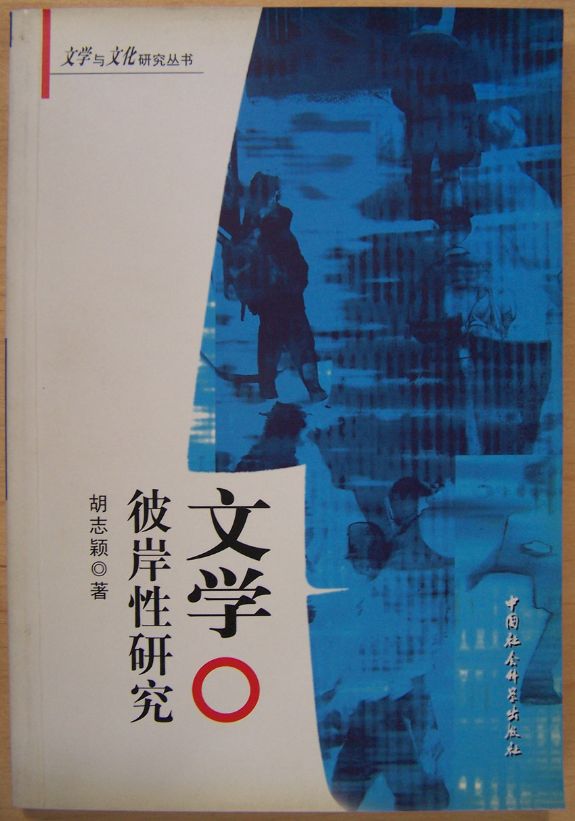|
|
|
 |
新闻详细信息 |
 |
|
|
|
一个人的海市蜃楼
时间:2013-4-1 14:02:48 点击次数:5936 |
——关于胡志颖和他的艺术
● 杨卫
在中国当代艺术界,胡志颖是一位非常特殊的人物。这种特殊性不仅在于他的特立独行,从来不与潮流为伍,更在于他的学术身份,即作为一个画家,却赢取过文艺学博士的桂冠。正是因为这样的理论嗜好,与艺术的直觉相联系,使胡志颖超越了一般画家的感受,而又没有职业理论家的那种酸腐之气。我认为,要研究胡志颖的艺术,必须得结合他的文艺思想,只有将他的理论思考与艺术实践看作一个有机的整体,我们才能进入胡志颖的艺术世界,找到一把理解他探索实践的钥匙。
早在2002年,胡志颖就获得了暨南大学的文艺学博士学位,而他的博士论文完全与绘画无关,涉及的是文学,侧重于语言分析。他的博士论文为《文学彼岸性研究》。(图1)这是一个关于语言哲学的命题,以文学的彼岸性,即语言的极限思维作为研究对象,其抵达的幽暗层次与文化深度,很容易让人窒息,以至于变得束手无策,甚至虚无缥缈。而胡志颖却能够沉浸于这种晦暗幽闭的窒息之中,精研锐思,条分缕析,从中找到一条思想的出路,足可以反映他的思辨能力与理论素质。很难想象一个热衷于形象思维的画家,会对如此艰深的理论发生兴趣,如果不是心灵受到过彼岸世界的召示,人很难有这样的思想诉求。我总想,胡志颖在绘画创作上保持自己的独立姿态,不为潮流所动,其内在的原因可能就在于此,在于他一以贯之的终极关怀。
当然,胡志颖并非不识人间烟火,更不是逃避现实。恰恰相反,他对终极问题的热衷,根本上还是为了给我们存在的这个时空注入一种人文深度。这就像他在文学的彼岸性研究中旁证博引一样,他的绘画创作也无不关乎着当代人的生命体验,与时代精神紧密相联。纵观胡志颖从事绘画创作的历史,我们能够看到他的个人线索与各个时期的文化思潮之间的共振关系。比如1979年他就创作过有关“红卫兵”伤害题材的作品,(图2)这与当年的“伤痕美术”思潮几乎是处在同一个起跑线;再比如他在1989年前后创作的一批“抽象水墨”,以一些东方的神秘符号为元素,也无不表现了在西方现代艺术的影响下寻找主体意识的突围。实际上,这跟“85新潮”以来,中国现代艺术整体呈现出的影响焦虑,也有着藕断丝连的内在联系……看得出来,胡志颖在绘画创作上并不是闭门造车,而是一直带着当代人的问题意识往前推进,只不过受终极理想的价值启迪,他没有浅尝辄止,把自己探索的步伐停止于某个思潮或某个现实问题而已。
正是因为胡志颖的这种不懈探索精神,驱使他一次次地超越自我,将自己的绘画艺术不断引向历史的纵深,到后来与更大的文化背景联系在了一起。二十世纪九十年代以后,胡志颖在从事了一段时间“抽象水墨”的试验之后,画面逐渐隐现出了一些传统山水画的意象。这可以理解为胡志颖对现实世界的超越,已经不再是简单地关心现实问题,而是遨游于浩瀚汪洋的历史大海,将自我的现实纳入到了文化传统的悠悠长河之中。我注意过胡志颖对中国传统山水画的意象捕捉,并不是元明成熟起来的文人山水,而是倾向于早期的北宋山水画,即还没有形成笔墨传统之前那种直面山川的表达。事实上,山水画自从被文人截取,形成“寄乐于画”(董其昌)的传统之后,山水的意向便已经与文人的情怀融合在一起,原本的敬畏之心就逐渐被“墨戏”所取代了。但在笔墨还没有突显之前,比如北宋时期的山水画,那里面透露出来的生疏感,以及突兀与奇异的效果,还折射着人们面对自然时的某种恐惧。我由此想到胡志颖为什么没有选择元明的文人山水,而是独独钟爱于北宋之前的山水画?原因就在于他对彼岸世界的眷念,已经使他感受了太多的精神历险。
事实上,险象环生的境遇,早就构成了胡志颖艺术作品的一个核心内容。这就像他涉及到中国传统山水画意象的系列绘画,作品的表征往往还布满了繁杂的生命图腾一样。如此这般剪不断理还乱的表现方式,体现了胡志颖对现实社会错综复杂的感受。而就这种现实感受来说,在他2007年前后创作的一批组画中表现得最为强烈。我们从中看到了胡志颖对现实世界的挣扎与反抗。也许正是因为感受到了现实社会的诸多困境,胡志颖才憧憬于彼岸,在他的文艺理论与艺术创作中不断寻找超越的契机。这也正所谓“愤怒出诗人”,重要的是有愤怒,还有良知。只是对于胡志颖而言,这种愤怒和良知,已经被他深厚的理论修养转换成了某种文化理想,以及不断超越自我的人文精神。
(原载《在幻象锁链的彼岸,胡志颖绘画作品1989—2009》,中国环球文化出版社,2010)
The Mirage of a Single Person
– About Hu Zhiying and His Art
Yang Wei
In the world of contemporary Chinese art, Hu Zhiying is a very particular person. This particularity consists not only in his being independently minded and keeping from the tide, but also in his academic identity, that is, though a painter, he has obtained a doctor’s degree in the study of art and literature. It is the combination of predilection for theory and artistic intuition that enables Hu to excel common painters in sensibility and to be free from the pedantry of professional theorists. In my opinion, to make a study of Hu’s art, we must take into account his thought on art and literature, and only if we view his theoretical reflections and artistic practice as an organic whole will we be able to enter the art world of Hu and to find the key to the understanding of his exploration and practice.
As early as 2002, Hu obtained a doctor’s degree in the study of art and literature at Jinan University. His doctoral thesis has nothing to do with painting, but deals with literature instead, with emphasis on linguistic analysis. His thesis is titled “On the Paramitality in Literature” (fig. 1). As a proposition of linguistic philosophy, it takes the Paramitality in literature, i.e. the ultimate lingual thinking as its object of research and reaches such a degree of obscurity and cultural depth that one will feel suffocated, helpless, or even illusory. It suffices to show Hu’s speculative ability and theoretical level that he can find a way out, in terms of thinking, in such an obscure and suffocating state by researching in depth and making analysis carefully and in detail. It is hard to imagine that a painter, who is keen on thinking in images, will take an interest in such an abstruse theory. Without being summoned by the world of the Paramita, one could hardly have such an ideological pursuit. I always think that the internal reason why Hu maintains his independence in his artistic creation, insusceptible to the tide, probably lies in this, in his consistent ultimate concern.
Certainly, Hu is not indifferent about mundane affairs and does not shun reality. On the contrary, fundamentally speaking, it is for the sake of adding a humanistic depth to the time and space we live in that he is keen on ultimate problems. Just as he quotes copiously from many sources in his thesis “On the Paramitality in Literature”, all of his painting creations have something to do with life experience of contemporaries, and is closely connected to the spirit of the age. Taking a sweeping view of the history of his painting creation, we can see a resonant relationship between his paintings and cultural trends of thought of various periods. For example, the painting about the trauma of the “Red Guards” he produced in 1979 (fig. 2) is almost on the same starting line with the “Trauma Art” trend of thought of that time. For another example, all the “abstract ink and wash paintings” with some Eastern mystic symbols as elements he produced around 1989 manifest, without exception, his attempt to find a breakthrough of subjective consciousness under the influence of modern Western art. Actually, this has some inner relation with the anxiety of influence that the whole modern Chinese art showed after the “’85 New Trend”.... Obviously, Hu does not engage in painting creation irrespective of external circumstances; instead, he proceeds with the problem consciousness of a contemporary, only that inspired by the value of ultimate ideal, he is not satisfied with a superficial attempt and has not confined himself to a certain trend of thought or practical problem.
It is this spirit of persevering exploration that makes him surpass himself again and again and bring his art of painting to the depth of history continuously so that it is connected with the larger cultural background afterwards. After he made some experiments on “abstract ink and wash” for a period in the 1990s, there emerged some images from traditional landscape paintings in his works. It can be understood in this way: his transcendence of the real world no longer lies in merely concerning himself with practical problems; instead, he now swims in the boundless sea of history, bringing his own personal reality into the long river of cultural tradition. I have noticed that the images from landscape paintings Hu captured is not those from the matured literati landscape paintings of the Yuan and Ming Dynasties but those from the early landscape paintings of the Northern Song Dynasty, that is, the direct depictions of mountains and rivers before the brush and ink tradition came into being. In fact, since the scholars took over the art of landscape painting and the tradition of “painting for pleasure” (Dong Qichang) formed, images of landscape painting have been blended with thoughts and feelings of scholars, and the original awe has been replaced by the “ink play” gradually. However, the unskilledness and the abrupt and fantastic effect manifested in the landscape paintings done before brush and ink gained dominance, for example in those of the Northern Song Dynasty, still reflect man’s fear before nature. This brings me the question: why has Hu not chosen the literati landscape paintings of the Yuan and Ming Dynasties but is interested solely in those of the Northern Song Dynasty in stead? The reason is that his deep affection for the world of Paramita has led him to too many spiritual adventures.
In fact, the experience of being beset by dangers has long become a core content of his art works. For instance, his series of paintings involving images from traditional Chinese landscape paintings are often fraught with miscellaneous totems of life. Such anfractuous representations reflect his complicated feeling of the real world. This practical feeling is manifested most strongly in a group of series he produced around 2007. We have seen in them his struggle and resistance against the real world. Perhaps just because he has experienced so many predicaments of the real world, Hu longs for the world of the Paramita, and keeps looking for chances to surpass the real world in his literary theory and artistic creation. Just as the saying goes, “anger produces a poet”. In fact, the important thing is the presence of anger and conscience. Only as far as Hu Zhiying is concerned, due to his profound mastery of theories, this anger and conscience have been transformed into a certain cultural ideal and the humanistic spirit of continuous self transcendence.
(Originally published in the Beyond the Chains of Illusion, Hu Zhiying’s Paintings from 1989 to 2009, China Global Culture Publishing House, 2010)
(图1)
胡志颖著作《文学彼岸性研究》
(Fig. 1)
Hu Zhiying's PhD thesis “On the Palamitality in Literature”
(图2)
无辜 1979,纸上水粉,80×120cm
(Fig. 2)
Innocent 1979, gouache on paper, 80×120cm
杨卫:
批评家,策展人,宋庄艺术促进会艺术总监
Yang Wei: critic, curator, art director of Songzhuang Art Promotion
Association
|
|
 |
|
 |
|


